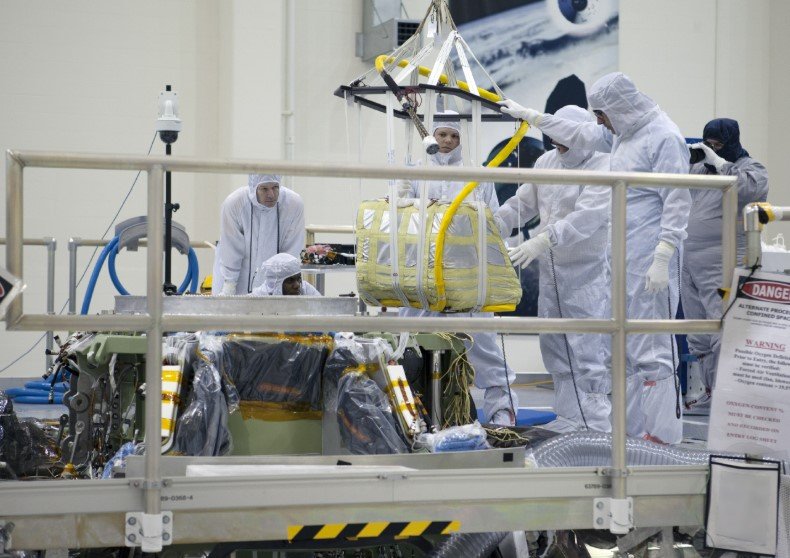NASA has reached a key milestone by installing the Orion spacecraft on top of the Space Launch System rocket for the Artemis II mission. This step happened at Kennedy Space Center in Florida on October 22, 2025, bringing the first crewed flight around the Moon closer to its planned launch in early 2026.
Major Step Forward in Moon Exploration
Teams at Kennedy Space Center carefully lifted and attached the Orion capsule to the massive SLS rocket inside the Vehicle Assembly Building. This assembly marks the completion of the rocket’s main structure, ready for further tests before launch.
The Orion, built by Lockheed Martin, got its name “Integrity” to highlight its strong design for deep space travel. Workers fueled it earlier in August 2025 and added the launch abort system for crew safety. Now fully stacked, the whole setup stands tall, showing progress in NASA’s push to return humans to lunar orbit.
This event comes after years of preparation, including the successful uncrewed Artemis I mission in 2022. That flight tested Orion’s systems without people on board. Now, with humans set to fly, excitement builds for what could be a game changer in space travel.
Experts say this stacking reduces risks and keeps the project on track despite past delays. The mission aims to prove that Orion and SLS can safely carry astronauts beyond Earth orbit.

Inside the Orion Spacecraft
Orion is designed to keep four astronauts safe during their 10-day journey around the Moon. It includes advanced life support systems, navigation tools, and radiation shielding in key areas to protect against space hazards.
The capsule measures about 10 feet tall and 16 feet wide, with room for crew to move, eat, and sleep. Its heat shield, tested in Artemis I, will handle the intense heat of reentry at speeds up to 25,000 miles per hour.
Key features of Orion include:
- Solar arrays that unfold to provide power from the Sun.
- A service module built by the European Space Agency for propulsion and supplies.
- Emergency escape systems that can pull the crew away from danger during launch.
These elements make Orion more advanced than the Apollo capsules used in the 1960s and 1970s. NASA has focused on reliability, drawing from lessons learned in recent Mars rover missions and International Space Station operations.
Meet the Artemis II Crew
The four astronauts chosen for Artemis II bring a mix of experience and diversity to the mission. They will test Orion’s systems in real time, gathering data for future landings on the Moon.
NASA selected the crew in 2023, including three from the United States and one from Canada. This international team shows growing partnerships in space exploration.
Here is a quick look at the crew members:
| Name | Role | Background |
|---|---|---|
| Reid Wiseman | Commander | Navy pilot with prior space station mission. |
| Victor Glover | Pilot | First Black astronaut to pilot a spacecraft to the Moon. |
| Christina Koch | Mission Specialist | Holds record for longest single spaceflight by a woman. |
| Jeremy Hansen | Mission Specialist | Canadian astronaut with military flying experience. |
Training has ramped up in 2025, with simulations of the flight path and emergency scenarios. The crew has expressed enthusiasm about inspiring the next generation, linking this mission to broader goals like Mars exploration.
Their journey will loop around the Moon without landing, but it sets the stage for Artemis III, which plans to put boots on the lunar surface in 2027.
Launch Timeline and Challenges Ahead
Artemis II targets a launch window opening on February 5, 2026, though teams are preparing for possible shifts to April. Monthly windows depend on Earth-Moon alignment, and daily slots last just hours.
Before blastoff, the stacked rocket will undergo integrated tests, including a wet dress rehearsal where fuel is loaded and countdown procedures are practiced. These steps ensure everything works together.
Past challenges, like delays from the 2024 core stage rollout and government shutdowns, have been overcome. NASA got special approval to keep working on critical parts during recent budget issues.
If all goes well, the mission will last about 10 days, with Orion skipping across Earth’s atmosphere on return for a softer landing. This technique, new for crewed flights, adds to the excitement and learning potential.
Why This Mission Matters Now
Artemis II is more than a test flight; it revives human deep space exploration after over 50 years. It ties into current trends, like private companies building lunar landers and international efforts to establish a Moon base.
This mission supports NASA’s goal of sustainable presence on the Moon by the end of the decade. It also boosts technology that could help with climate monitoring from space and asteroid mining ideas.
In a world facing rapid tech changes, such as AI advancements in 2025, Artemis shows how space pushes innovation. It inspires students and creates jobs in engineering fields.
As we look ahead, this step reminds us of humanity’s drive to explore. Share your thoughts on the Artemis program in the comments below, and spread the word to keep the conversation going.
